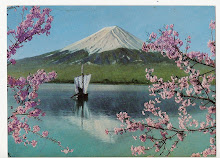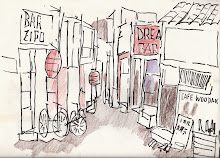LOOKING THROUGH YOUR PHOTOSTREAM...makes me so sad that I did not visit Hokkaido while I was in Japan. But I shall, if it is possible, visit this beautiful island of Japan when I visit Japan once more sometime in the next year or so. Yes, it appeared so rural and natural from the 60s photos. I know I would have fallen in love with Hokkaido as I did the main island. You have a most fantastic collection of photos. Robert
Thank you for your permission to place a few of them in my BLOGABOUTJAPAN
YOKOHAMA PICTURE SHOW

Shot with my Petri in Yokohama 1962
RICE FIELD IN JAPAN 1962

I took this with my PETRI in Kanagawa Prefecture
Thursday, May 12, 2011
Chitose6404
Streetcar in Tokyo near Shinbashi Station, circa 1955
Streetcar in Tokyo near Shinbashi Station, circa 1955
Mid 1950s Tokyo. A horde of pedestrians crosses in front of a 6000-series Tokyo metropolitan streetcar.
The sign in the foreground says that this is A Avenue and 10th Street. The US military imposed a system of street names on the major thoroughfares in Tokyo after the end of World War Two. Lettered avenues radiated from the Imperial Palace clockwise. "A Avenue" ran south from the southeast corner of the Imperial palace, on Hibiya Boulevard (Hibiya Doori). The numbered streets were basically major roads essentially ringing the palace. 10th is Outer Moat Boulevard (Sotobori Doori). So this is the Nishi-shinbashi Crossing, just south of Hibiya Park. At the time the neighborhood - and the streetcar stop - was called Tamuramachi (田村町). We must be looking east, because the sun is hitting the face of the building on the right.
It pre-dates 1957, when Tokyo's streetcars were repainted yellow. The lines which ran on Hibiya Doori through this intersection were 1, 5, 35 and 37.
Here's a zoom on a part of the map published by the US military in 1948 with the street names.
And here's the neighborhood on an interactive 1956 map of Tokyo.
Found in an antique store's photo bins.
______________________________________________________________________
COMMENTS FROM ROBERT L. HUFFSTUTTER
One of the joys of having been stationed in Japan for over two years was that the dollar was worth 360 yen at that time, but it was the people, always polite, nice and helpful. Not once in 28 months did I ever have a bad experience and I wandered off into the depths of Tokyo in the middle of the night. The streetcars were almost like an amusement park ride, especially late at night around the Bund in Yokohama. They would get up some real speed, sparks would fly and the entire care would shake, rattle and roll. Yes, for ten yen I could ride all over. I just got on the streetcars and let them take me wherever. For a young guy 19, Japan was like one big holiday without end. Unfortunately, my tour ended. See my BLOGABOUTJAPAN for more about streetcars
Thanks to Rob Ketcherside for posting this found photo--it brings back some warm memories, though bittersweet at times because of the SAYONARA FACTOR....
Izakaya at road side
IZAKAYA AT ROADSIDE BY NOBUOJP
This a perfect example of the Japanese sake bars I saw while spending a tour of joyful duty in Japan in the early 1960s. While these were for the local Japanese, whenver an American wondered in, he was treated with respect and offered sake. In Yamato, I had a favorite sake bar I frequented.
On more than one occasion, my Japanese friends made sure I made it home to my small apartment in Yamato. 50 years have passed, but I still have warm memories of my time in Japan whenever I see photos like these with many lanterns. Thank you for sharing this special photograph. Robert











